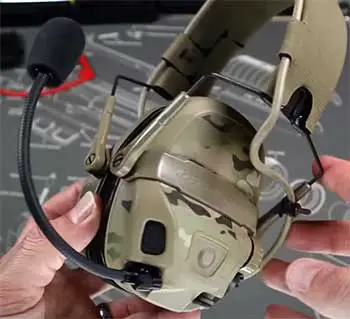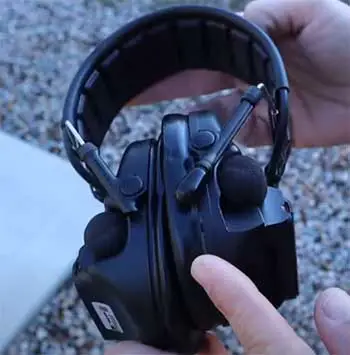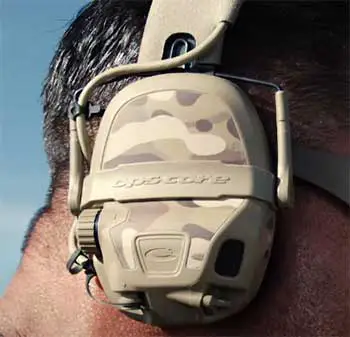When it comes to choosing a tactical headset, two of the most popular options on the market are the Ops-Core AMP and the Peltor range. Both brands offer high-quality audio accessories designed specifically for military, law enforcement, and security professionals.
But with so many models available from each manufacturer, deciding between Ops-Core and Peltor can be a challenge. This article provides a detailed feature-by-feature comparison of these two leading tactical headsets to help you select the right option for your needs and budget.
Key Differences Between Ops-Core AMP and Peltor
Before diving into the specifics, here is a quick overview of how Ops-Core AMP and Peltor headsets differ:
- Purpose: Ops-Core AMPs are primarily designed for combat/tactical settings, while Peltor has models for both tactical and hunting/shooting.
- Durability: Ops-Core AMPs meet rigorous military specifications (MIL-SPEC) for ruggedness. Peltor duty models are durable but some hunting models are not as robust.
- Power: Most Ops-Core AMPs are electronically enabled to amplify sounds. Only some Peltor models have power-assisted hearing.
- Connectivity: Ops-Core headsets can integrate helmet-mounted accessories through a rail connector. Most Peltors use traditional headband.
- Price: Ops-Core AMPs have a higher price tag than most Peltor options. But Peltor does offer very premium models.
Keep these key differences in mind as we explore the product ranges in more detail below.
Ops-Core AMP Overview

The Ops-Core AMP line encompasses five core headset models: the AMP, AMP-P, AMP-C, AMP-CT, and AMP-1. As a group, these headsets deliver best-in-class hearing protection and communication capabilities optimized for demanding tactical environments.
All Ops-Core AMP models feature layered hearing protection combining natural passive attenuation with active noise cancellation (ANC).
This hybrid approach blocks unsafe impulse sounds while still allowing situational awareness of ambient noise.
The communications function is facilitated through a microphone and speaker system fully integrated with the earcups. Most Ops-Core AMP options also include a universal connector that is rail-mounted to attach helmet accessories.
Within the product range, different models cater to specific mission requirements. For example, the AMP-P integrates a mandibular microphone near the mouth for improved voice pick-up, while the AMP-CT combines coaxial tactical input/output cables to interface with radios.
In terms of durability, Ops-Core AMP headsets are engineered for hardcore field use. The headsets meet rigorous MIL-STD-810G standards for shock, vibration, temperature extremes, and other environmental exposures. Rugged materials like stainless steel metal headbands withstand years of outdoor operations.
When it comes to price, Ops-Core AMPs sit at the premium end, with most models starting around $1,100. But that higher price tag does deliver best-in-class audio capabilities purpose-built for military and law enforcement professionals operating in extreme environments.
Peltor Headset Overview
The Peltor brand encompasses a diverse range of headset products tailored for military, law enforcement, shooting sports, industrial, and even consumer users. As a result, Peltor headsets vary more widely than Ops-Core models in terms of technical capabilities and pricing.
Like Ops-Core, some Peltor models offer layered hearing protection combining passive and powered amplification. But many Peltor headsets rely solely on passive sound dampening through thick earcups.
Communications and connectivity similarly differ across the lineup—some Peltor options have built-in microphones and headset jacks, while others require pairing separate microphone accessories.
Given the wide variety across Peltor models, it is useful to divide the lineup into three broad categories:

- Tactical Duty Headsets – Designed for military, law enforcement, and private security roles. Rugged and high-tech but expensive. Examples are the COMTAC III ACH headset and Tac 300.
- Hunting/Shooting Headsets – For recreational sport shooting and hunting applications. Durable construction but fewer high-end features. Examples are the RangeGuard and ProHunter models.
- Work Safety Headsets – Entry-level headsets for industrial workplace noise reduction. Basic functionality and affordable pricing. Examples are the Workstyle and Optime I models.
Only the tactical and shooting headset models deliver capability levels and durability comparable to Ops-Core AMPs.
The work safety headsets are more affordable options not made for extreme environments.
Across the entire Peltor range, pricing stretches from around $100 up to over $500 for the most high-end tactical models. So Peltor does offer great versatility in balancing capability demands with budget constraints.
Head-to-Head Comparisons
Now that we have provided overviews of the Ops-Core AMP and Peltor product families, let’s directly compare some of the most popular models according to key performance metrics:
- Sound Protection and Enhancement
When it comes to blocking hazardous noises while maintaining situational awareness, Ops-Core AMPs leverage an ambidextrous speaker design with two microphones feeding adaptive cancellation algorithms. This powered amplification actively filters noise instead of just relying on passive insulation provided by the 1⁄2 inch thick earcups.
By comparison, most Peltor tactical headsets combine dual layered earcups with microphones and speakers in each earpiece. But instead of active noise cancellation, amplification relies on analog circuitry to compress dangerous impulse peaks.
For both brands, their higher-end models allow hearing safe sounds at volumes as low as 45dB while blocking noises over 105dB. Entry-level and shooting-specific Peltor options may not actively amplify sound but still provide around 30dB noise reduction through thick padding.
Winner: Ops-Core AMP for more advanced powered amplification, ambient listening capabilities, and consistent attenuation performance across models.
- Durability and Protection

As discussed previously, Ops-Core AMP headsets adhere to military specifications (MIL-STD-810G) covering shock, vibration, temperature extremes from -60F to 160F, and water immersion.
Peltor tactical headsets similarly meet rigorous standards needed for military usage.
But hunting and recreational shooting models may not deliver the same level of hardcore durability.
In terms of integration with helmets and headborne equipment, Ops-Core AMPs feature a universal connector to securely mount to standard rails.
And the coaxial IPS connectors allow low-profile connection to communication devices.
Most Peltor headsets utilize traditional headbands and headset jacks for more flexible compatibility across various professional and recreational platforms. But adapters are available for integrating Peltor tactical models with rails and helmet-mounted accessories.
Winner: Draw. Ops-Core wins for out-of-the-box helmet integration but both brands deliver equivalent durability for tactical applications. Peltor offers greater flexibility for hunting/shooting purposes.
- Hearing Enhancement and Communications
Ops-Core and Peltor models both integrate internal speaker systems and microphones for communications and hearing sound enhancement. But there are some differences across models:
- Ops-Core AMP options feature wind-resistant noise-cancelling boom mics designed specifically for aircraft operation. Most Peltor headsets rely on small goose-neck microphones.
- Higher-end Ops-Core AMP-Ps position the mic at mouth-level for superior voice pickup while the AMP-CT optimizes radio cable connections.
- Entry-level Peltor shooting headsets may lack built-in microphones and speakers thus requiring pairing separate accessories for hearing enhancement and communications.
In high noisy environments, Ops-Core’s powered amplification delivers superior audio quality from the integrated speaker systems. That allows for better situational awareness and incoming communications clarity when ambient sound levels exceed ~85dB.
But when noise is limited, both brands enable good communications and sound enhancement—especially for their respective higher-end models.
Winner: Ops-Core AMP. Superior microphone positioning, built-in speaker audio quality, and availability across all models.
- Cost and Budgetary Considerations

There is no question Ops-Core AMP headsets sit at the premium end of the market with most models starting around $1,100.
That gives Peltor solutions a definite edge in pricing and budget flexibility.
Peltor tactical headsets range from around $350 to $500—still a hefty investment but 60% less than comparable AMP options.
And Entry-level Peltor shooting/work safety models dip as low as $100.
If budget remains a primary factor, Peltor cannot be beaten.
But Ops-Core does deliver more advanced capabilities purpose-built for extreme military environments—so you generally get what you pay for.
Winner: Peltor. Much wider range of price points and budget-friendly options without sacrificing core capabilities needed for hunting and some professional security roles.
Usage Recommendations
Based on our detailed comparison, here are some specific usage recommendations to help choose between Ops-Core and Peltor:
- For hardcore military combat operations requiring long-term durability plus high-fidelity enhanced hearing/communications, Ops-Core AMPs are worth the premium investment.
- For law enforcement and private security professionals not needing advanced sound amplification, Peltor COMTAC III or Tac 300 models provide sufficient tactical capabilities for 60% less cost.
- Hunters, target shooters, and industrial workers on a tight budget should select affordable Peltor sporting and work safety models offering adequate communications/protection.
- First responders wanting helmet integration with good durability can still save money by pairing adapters with Peltor solutions instead of investing in Ops-Core AMPs.
Of course, personal preferences differ so also try out models firsthand yourself whenever possible. But considering the key factors above will set realistic expectations on matching performance to price.
Also Read: Comparison of BlueParrott 650 And 550 Bluetooth Headsets.
Frequently Asked Questions (FAQ)
Here are answers to some common questions about Ops-Core and Peltor headsets:
Most Ops-Core AMP headsets meet military specifications for water resistance but they are not fully waterproof. They can withstand exposure to sustained moderate rainfall or heavy dripping but cannot be submerged underwater for longer periods. Peltor tactical models offer similar levels of water protection.
The Downlead cables on Ops-Core AMP headsets are what connect into communication radios and other audio accessories. Connectorized Downleads feature a quick-disconnect 3.5mm or NATO plug that users can swap out. That allows tailoring headset compatibility to different radio systems.
Fixed Downleads hardwire the headset connections for simpler operation but less flexibility. You must choose the right connector compatibility upfront based on the radio system.
Comtacs refer to any of the COMTAC tactical communication headset models made by Peltor. As discussed earlier, while expensive, Comtacs deliver proven durability, sound protection, and communications capabilities trusted widely among military and law enforcement.
So for professionals working in hazardous situations, the significant $350-$500 investment for Comtacs is usually worth it over cheaper alternatives that might fail in crucial moments. But hunters and recreational shooters probably don’t require Comtac specs making lower-end models more cost-effective.
The COMTAC III and COMTAC VI represent the latest generations of the COMTAC tactical headset line from Peltor. The VI is the newer release with updates focused mainly on physical design.
In terms of audio, both models provide equivalent protection and amplification based on twin microphone processing with dynamic suppression time. But the slimmer and lighter COMTAC VI features revised earcups and padding plus an upgraded headband for added comfort, stability, and compatibility with protective equipment.
So unless weight and wearing size is a major factor, the proven COMTAC III likely meets most user needs while saving on cost compared to the slightly updated VI model.
Closing Remarks
Hopefully this detailed side-by-side comparison gives you a helpful framework for deciding between Ops-Core and Peltor headset solutions tailored to your specific professional needs. Let the mission requirements, feature trade-offs, and budget inform the right solution for the situation.

